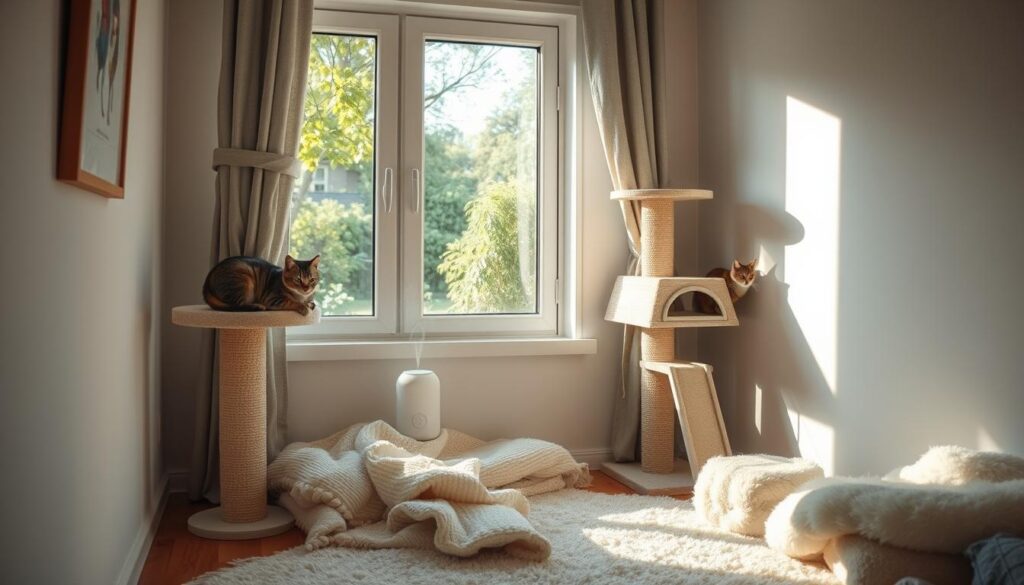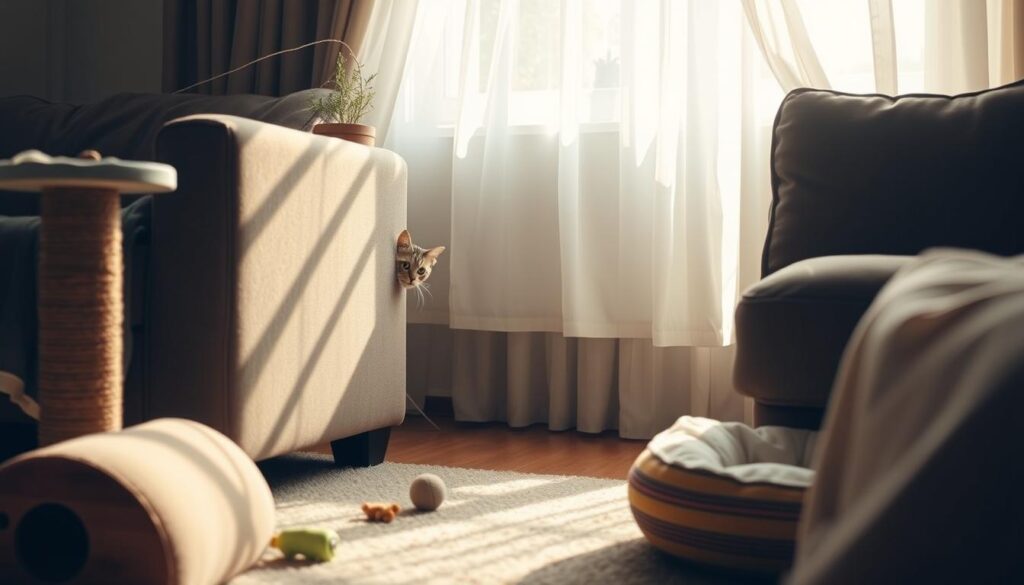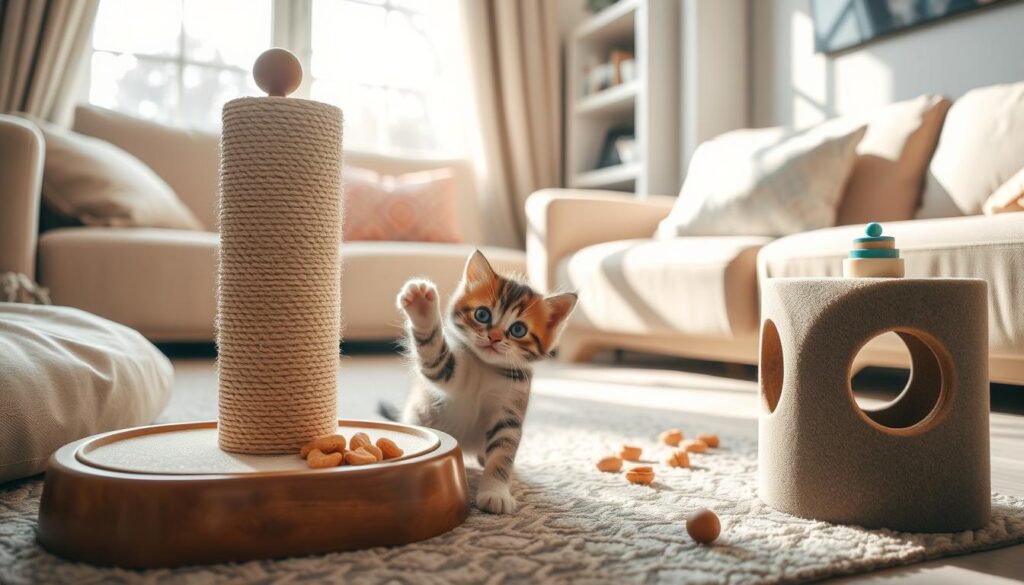When you bring a new cat home, make it calm and welcoming. For Pet’s Sake Rescue has helped over 15,000 cats find new homes. They know that getting ready and being patient helps your cat feel at home.
Get a safe spot ready with things like a litter box, food, water, and toys. Let your cat explore your home slowly. This helps them feel less stressed and makes the move easier for both of you.
Table of Contents
Understanding Your New Cat’s Background
Welcoming a new cat into your home is exciting. Knowing their background helps you understand their behavior and health. It also prepares you for their new life with you.
Adoption vs. Rescue Organizations
Adopting from a shelter or rescue has its perks. Staff and volunteers know a lot about the cat’s personality and past. Rescue groups often share detailed histories, helping you meet your cat’s needs.
This knowledge helps you prepare your home and yourself. It makes the transition smoother for your new pet.
Recognizing Behavioral Traits
Watching your cat’s behavior tells you a lot. Shyness might mean they were neglected or abused. Confidence and love could show they had a good start in life.
Knowing these traits helps you create a safe and loving space. It supports feline behavior and cat socialization.
Assessing Health and Wellness
Getting a vet check-up is key for your cat’s health. It spots any medical issues early and helps plan for their future care. This ensures your cat stays healthy and happy.
| Metric | Values |
|---|---|
| Initial Cat Weight | 16 pounds |
| Post-Diet Weight | 9 pounds |
| Weight after Changes | 11 pounds |
| Recommended Weight | 9 pounds |
“Overweight cats can develop serious health issues like diabetes, heart disease, and orthopedic problems. It’s crucial to work closely with your veterinarian to find the right diet and feeding schedule for your cat’s individual needs.”
Preparing Your Home for the New Cat
Getting a new cat is exciting. But, your home needs to be ready for them. Make sure it’s safe and comfy for your cat. This helps them feel at home without stress.
Creating a Safe Space
Choose a special room for your cat. It should have a litter box, food and water, scratching posts, and soft bedding. This room lets your cat get used to their new home slowly.
Essential Supplies You’ll Need
- High-quality cat food and treats
- Multiple water and food bowls
- Litter box and litter
- Scratching posts and pads
- Cat toys and interactive playthings
- Comfortable bedding and cat beds
- Cat carrier for transportation
Cat-Proofing Your Environment
Look around your home for dangers. Remove toxic plants, loose wires, and small spots where your cat might get stuck. Make sure windows and balconies are safe. You might need to cover your furniture to keep it from getting damaged.
| Safety Measure | Importance |
|---|---|
| Removing toxic plants | Prevents accidental ingestion and potential poisoning |
| Securing loose wires | Eliminates the risk of entanglement or chewing |
| Blocking small spaces | Ensures your cat doesn’t get trapped or injured |
| Securing windows and balconies | Prevents falls and escapes, keeping your cat safe indoors |
Make your home safe for pets. Get all the cat supplies you need. And, take steps to keep your home safe. This way, your new cat will have a happy and safe place to live.

Gradual Introduction to Family Members
Bringing a new cat home needs care and thought, especially with family around. It’s important to help your new cat get used to everyone. A slow introduction helps everyone get along better.
Introducing to Children
Teaching kids how to be gentle with cats is key. Tell them not to move too fast or touch the cat too much. Give treats and praise when they act well. Make sure the cat has a safe place to go if they’re scared.
Meeting Other Pets
Introducing a new cat to other pets needs extra care. Start by letting them smell each other. Watch them meet face-to-face and reward calm behavior. Slowly increase their time together to help them feel safe.
Ensuring Positive Interactions
Make sure everyone has a good time when they meet. Give treats and toys to show you’re happy. If things get too tense, step in to keep things calm.
Using these steps, your new cat will fit right in. It doesn’t matter if you have multi-cat households, a pet, or are adjusting to a new family member. With patience, your cat will feel like part of the family.
The Importance of a Slow Introduction
Getting a new cat is exciting but can be hard. It’s key to introduce them slowly to reduce stress. This helps your cat feel comfortable and adjust at their own speed.
Reducing Stress for Your New Cat
Cats are very sensitive and can get stressed easily. To help, use pheromone diffusers or sprays. They make the place feel calm. Let your cat explore slowly, so they feel safe.
Importance of Routine and Consistency
- Feed your cat at the same times every day.
- Make sure to play and give them attention regularly.
- Keep a daily routine, as cats like knowing what’s next.
These steps help your cat feel safe and loved. With patience, your cat will soon feel at home with you.

“The key to a successful cat introduction is to take it slow and allow your new pet to set the pace. With time and care, your cat will learn to feel at home in their new environment.”
Establishing Boundaries and Independence
When you bring a new cat home, it’s key to help them set boundaries. Cats love to explore and have their own space. Giving them places to climb and watch from above helps them feel cat independence and feline territory.
Playing and exploring are also important. Toys that make them think they’re hunting keep them busy. Make sure they have quiet spots to hide when they need pet boundaries.
Defining Personal Spaces
- Provide vertical spaces like cat trees or wall-mounted shelves for climbing and observation
- Designate specific areas of the home as your cat’s personal territory, such as a cozy bed or hidden nook
- Ensure your cat has access to elevated perches to survey their domain
Encouraging Exploration and Play
- Invest in engaging, interactive toys that stimulate your cat’s natural hunting instincts
- Dedicate regular playtime sessions to bond with your cat and encourage physical activity
- Create hiding spots and tunnels that allow your cat to explore and satisfy their curiosity
Setting boundaries for your new cat takes time. By giving them space and play, you help them be happy and healthy.
Monitoring Your New Cat’s Behavior
Getting a new cat is exciting. But, watching your cat closely is key. Look for stress or anxiety signs. These show your cat might be having a hard time adjusting.
Signs of Stress or Anxiety
- Hiding for a long time
- Too much grooming
- Changes in eating or using the litter box
- Yelling more or being mean
- Walking a lot or can’t relax
Positive Behavioral Indicators
Look for good signs too. These show your cat is getting used to the new place:
- Purring and kneading
- Wanting to play and get attention
- Exploring with curiosity
- Playing and using energy
When to Seek Professional Help
If your cat’s behavior doesn’t get better, see a vet or animal behaviorist. They can help find the cause and make a plan. With time and help, your cat will do great in their new home.

| Stress Signals | Positive Behaviors |
|---|---|
| Hiding, Excessive Grooming, Appetite Changes | Purring, Kneading, Seeking Attention |
| Increased Vocalization, Aggression | Exploring, Playing, Curiosity |
| Pacing, Restlessness | Engaging in Energy-Burning Activities |
“Watching your cat’s behavior and body language helps you spot problems. This way, you can make sure they adjust well to their new home.” – Dr. Jane Smith, Veterinary Behaviorist
Feeding Your New Cat
Getting a new cat is exciting. But, it’s key to know their special eating needs. This ensures they stay healthy and happy. Choosing the right food and a steady feeding routine is crucial for their dietary needs.
Choosing the Right Food
First, pick a top-notch cat food that fits their needs. Think about their age, how active they are, and any health issues. Talk to your vet to find the best cat food for your pet.
Setting a Feeding Schedule
- Make a steady feeding plan to keep your cat safe and healthy.
- Give them small meals often, not leaving food out all the time.
- Watch how your cat eats and adjust the schedule as needed.
Introducing Treats
Treats are great for rewarding your cat and strengthening your bond. But, give them out carefully to not mess up their dietary needs. Ask your vet about the right treats and how much.
“Proper nutrition is essential for a cat’s overall health and well-being. By choosing the right food, establishing a consistent feeding routine, and introducing treats judiciously, you can help ensure your new cat thrives in their new home.”
Training Your New Cat
Getting a new cat is exciting and rewarding. But, it also has its challenges. Training your cat is key. It helps with litter box habits and behavior.
Litter Box Training: Setting Your Cat Up for Success
Start litter box training right away. Show your cat where it is and keep it clean. Use good, unscented litter and have more than one litter box.
Give treats or praise when your cat uses the litter box. This helps them learn good habits.
Teaching Basic Commands: Positive Reinforcement Techniques
You can also teach your cat basic commands. Use positive methods like clicker training or treats. This helps them learn tricks like “sit” or “come.”
These sessions also make your bond stronger. They help with good behavior.
Addressing Behavioral Issues: Patience and Consistency are Key
You’ll face some challenges with your new cat. Issues like scratching furniture or meowing too much will happen. Deal with these problems quickly and consistently.
Give your cat things to do like scratching posts or toys. Be patient as they get used to their new home.
Bringing a new cat home is rewarding. But, you must be ready. Focus on training, teaching commands, and solving behavior problems. This way, you and your cat can live happily together.

Socialization Techniques for Cats
Bringing a new cat home is exciting. It needs careful planning and patience. You must create a safe space and work on bonding.
Play with your cat, cuddle when they want, and make good things happen. This makes them feel safe and happy in their new home.
Engaging in Playtime
Playtime is key for your cat’s health. Get toys that make them hunt, like wand toys and laser pointers. Play every day and see what they like.
Give treats when they act well. This makes them trust you more.
Approaches to Cuddling and Bonding
Cats can be very close to their owners. Start slow with cuddling and respect their space. Let them decide when to cuddle.
As they get more comfortable, they might want to cuddle more.
Creating Positive Associations
Introduce new things slowly and safely. This helps them feel more confident. Use treats and praise to show them it’s good.
This way, they learn new things are okay. It makes them less stressed.
Using these methods, you can have a great bond with your cat. Every cat is different. So, be patient and watch what they like. With time, your cat will be happy and well-adjusted.
Maintaining a Happy Environment
To keep your new cat happy and healthy, regular vet visits are key. These visits help check your pet’s health and fix any problems. They also give the care needed for your cat to stay well.
Regular Vet Visits
Keeping your cat healthy is very important. Make sure to take them to the vet regularly. This helps prevent sickness and keeps your cat’s teeth clean.
Understanding Lifelong Needs
Cats need different things as they get older. Give them toys, exercise, and food that fits their age. This helps them stay happy and healthy.
Fostering a Positive Home Atmosphere
A happy home is key for your cat’s well-being. Give them toys, scratching posts, and places to climb. Playing with your cat often strengthens your bond.

